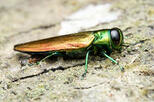Learn About Emerald Ash Borers
What are emerald ash borers?
Emerald ash borers are both local and spread across the United States. They breed in large numbers and emerge when the weather becomes warm each spring. Offices on a state by state level are attempting to contain and eliminate emerald ash borer populations, with no significant success. As a result of emerald ash borer growth and feeding, ash trees are perishing at alarming rates.
What do emerald ash borers look like?
The New Jersey Department of Agriculture identifies the emerald ash borer: “The adult is approximately 1/2” long and 1/8” wide, metallic green in color, with a metallic copper red abdomen. The larvae are white or cream colored, measure approximately 1 to 1 ¼” long and have 10 abdominal segments that are bell shaped.” They are no bigger than a penny, often making them difficult to spot.

hoto credit: http://www.lakesaintlouis.com
Surprisingly, adults cause little damage to ash trees other than chewing on their leaves. The most destructive phase in the lifecycle is the nearly invisible one: larvae. Emerald ash borer eggs are laid beneath the surface of ash tree bark, chewing galleries through the tree and causing irreversible damage. The larval state lasts 1-2 years before they emerge through signature D-shaped holes to mate. This means at least one year of damage occurs beneath the surface of the tree’s bark.
Why are emerald ash borers in New Jersey and Pennsylvania?
Not native to the United States, the first confirmed emerald ash borer infestation was in Michigan in 2002. Since then, the species has spread across the country and into parts of Canada. Although the source of their infestation is unknown, experts believe that the emerald ash borer entered the United States by boring into wood packing material shipped from Asia.
Why are emerald ash borers dangerous?
Emerald ash borers do not breed or overwinter in humanmade structures such as residential homes and commercial office buildings. They do not bite, sting, or transmit diseases that impact human and pet health. Keeping ash trees alive means saving a natural producer of oxygen into our environment as well as maintaining the aesthetic of your property and neighborhood. Because ash trees are common in residential neighborhoods in New Jersey and Pennsylvania, an invasion can become widespread very quickly.
We are not able to grow new ash trees at the rate that they are being destroyed, potentially resulting in total ash tree elimination. Ash trees are common to residential neighborhoods in suburban areas, providing an immediately negative risk to your home. When infected trees decay and die, they become frail and pose a significant fall risk which can severely damage your home or cause personal injury. Air conditioning costs rise as large ash trees that once provided shade become obsolete, not to mention the general aesthetics of decaying trees devaluing your home.
What should I do if I find emerald ash borers?
If you see an emerald ash borer or signs of emerald ash borer activity, visit the website below for directions guided by each state here.
How can E&G Pest Solutions help?
As the leading pest control company in NJ and PA, this update is for informational purposes since E&G Pest Solutions does not provide pest control services for emerald ash borers.
Want a Free Estimate?
Need to Schedule Service?
Have a Questions?
What our clients are saying
Our Partners and Awards
Service area
New Jersey:
Ocean County
Essex County
Passaic County
Morris County
Hudson County
Bergen County










